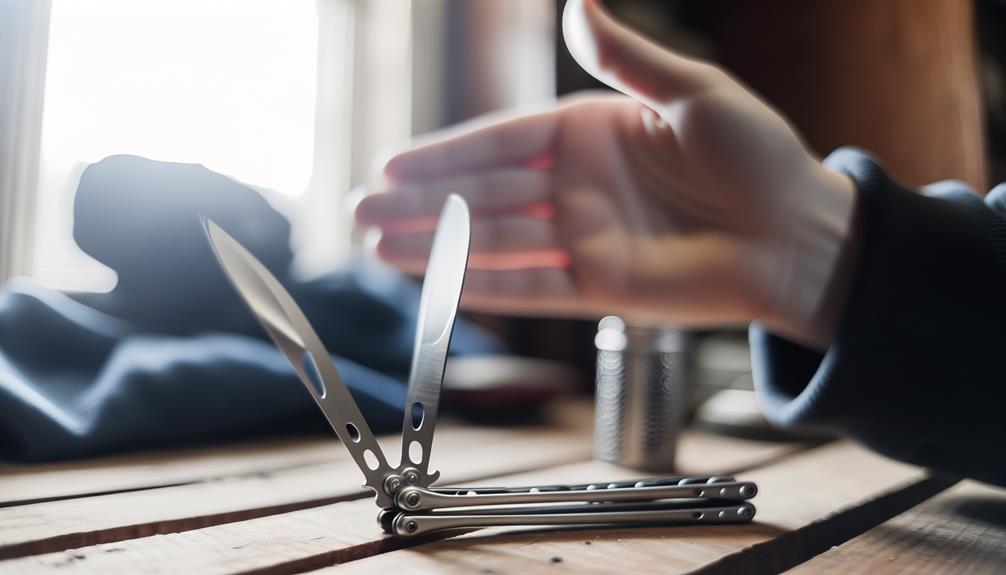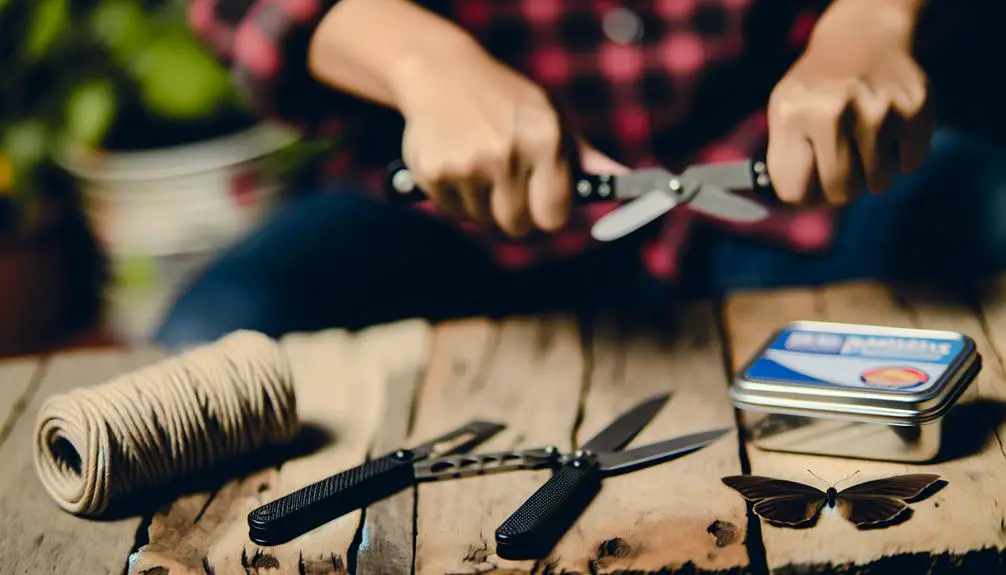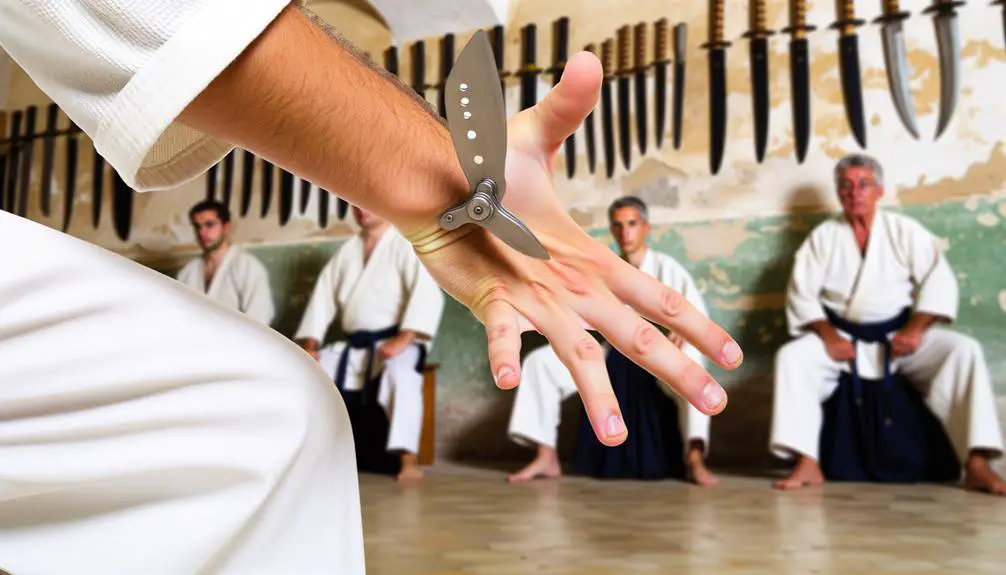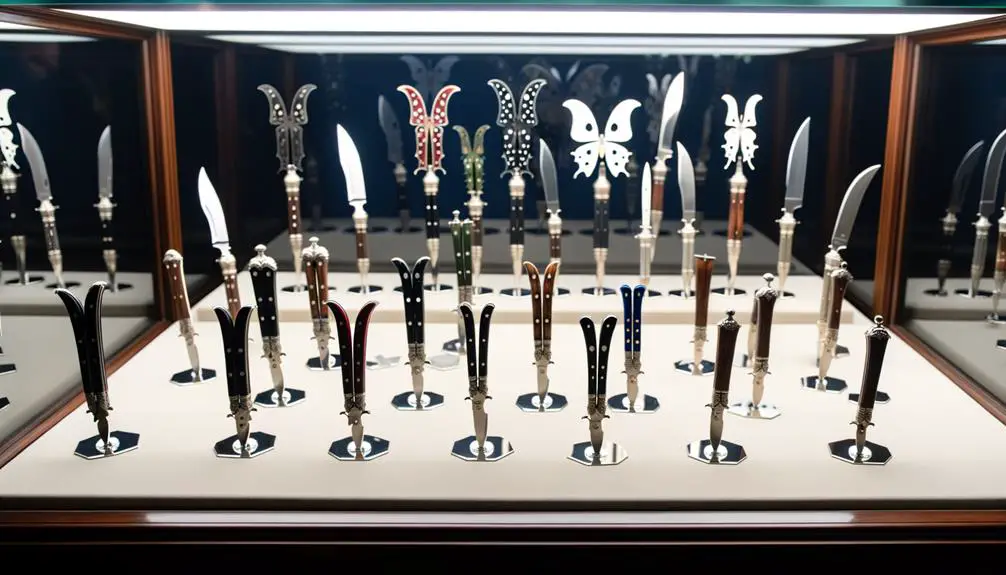How Are Butterfly Knives Used Today?
Butterfly knives, also known as balisongs, have multiple uses including everyday utility tasks like cutting rope and opening packages, due to their compact design and sharpness. They are useful in self-defense for their quick deployment and maneuverability in close-quarters situations.
In martial arts, they enhance hand coordination, reaction speed, and precision techniques. Additionally, butterfly knives are used in competitive flipping for dexterity and precision, and they are collected for their craftsmanship and rarity.
Although occasionally used in culinary settings for precision cuts, safety concerns limit this use. These diverse functions illustrate the knife's broad application spectrum.

Key Takeaways
- Butterfly knives are used for everyday tasks like cutting rope, opening packages, and slicing food.
- They are employed in self-defense due to their quick deployment and maneuverability in close quarters.
- Martial arts training utilizes butterfly knives to enhance hand coordination, reaction speed, and precision.
- Competitive flipping involves performing intricate tricks and manipulations, showcasing dexterity and skill.
Everyday Utility Tasks

Due to their compact design and versatile blade, butterfly knives can efficiently handle various everyday utility tasks such as cutting rope, opening packages, and slicing food.
The unique folding mechanism allows for secure storage and quick deployment, making it a practical tool for daily activities.
The blade's sharpness and durability are advantageous in performing precise cuts, whether severing fibrous materials or slicing through packaging.
Additionally, the ergonomically designed handle provides a firm grip, ensuring stability and control during use.
Butterfly knives also feature a locking mechanism that enhances safety by preventing accidental closure.
This combination of functionality and convenience makes them an excellent choice for individuals seeking a reliable, multi-purpose cutting instrument in their daily routines.
Self-Defense
In self-defense scenarios, butterfly knives offer the advantage of quick deployment, allowing the user to respond swiftly to immediate threats.
Their design is particularly suited for close-quarters combat, where maneuverability and rapid access are essential.
This combination of speed and utility makes butterfly knives a viable option for personal protection.
Quick Deployment Advantage
Mastering the quick deployment of a butterfly knife offers a significant advantage in self-defense scenarios, where reaction time is essential.
The design of the butterfly knife, with its two pivoting handles, allows for rapid, one-handed opening, providing immediate readiness. This capability is vital when split-second decisions can determine the outcome of an altercation. This unique mechanism not only enhances functionality but also adds an element of skill and finesse for users who practice flipping techniques. Enthusiasts often appreciate the knife not just as a tool but as an art form, similar to those who seek tutorials on how to draw a 3D butterfly, blending precision and creativity. The combination of speed, efficiency, and craftsmanship makes the butterfly knife a fascinating subject for both practical use and artistic representation.
The swift deployment mechanism guarantees that the user can swiftly shift from a passive to an active defense posture. Additionally, the mechanical simplicity and robustness of butterfly knives make them less prone to failure under duress.
Proficiency in handling this tool requires rigorous practice, but once mastered, it can offer a reliable edge in critical situations, enhancing personal safety and response effectiveness.
Close-Quarter Utility
The butterfly knife's close-quarter utility in self-defense scenarios hinges on its compact design and ease of maneuverability, allowing for effective engagement in confined spaces where larger weapons may be impractical.
Its folding nature provides a secure grip, facilitating quick shift between defensive and offensive actions. The dual-handle mechanism affords superior control, vital in high-stress environments.
Precision strikes can be executed with minimal motion, reducing the risk of telegraphing intentions to an adversary. Additionally, the blade's swift deployment guarantees readiness without compromising on stealth.
The butterfly knife's versatility extends to its ability to be concealed effortlessly, making it an ideal choice for self-defense in urban settings where discretion and rapid response are paramount.
Martial Arts Training

In martial arts training, butterfly knives serve as effective tools for enhancing hand coordination and improving reaction speed through their dynamic manipulation.
Practitioners also utilize these knives to develop precision techniques, owing to the intricate movements required for their proper use.
This specialized training not only refines motor skills but also sharpens overall combat proficiency.
Enhancing Hand Coordination
Utilizing butterfly knives in martial arts training greatly enhances hand-eye coordination and dexterity through intricate flipping and manipulation techniques.
These exercises demand precision and acute spatial awareness, pushing practitioners to synchronize their hand movements meticulously.
The constant flipping motions, such as rollovers, aerials, and spins, require a high degree of control and timing, fostering neuromuscular coordination.
This rigorous practice not only hones fine motor skills but also improves muscle memory, enabling smoother and more efficient movements.
Additionally, the varied grip positions and shifting sequences challenge the practitioner's adaptability and fluidity in handling the knife.
Through systematic training, martial artists develop superior manual agility and refined coordination, essential attributes for higher-level martial performance and self-defense proficiency.
Improving Reaction Speed
Mastering butterfly knives greatly enhances reaction speed in martial arts training, as practitioners must respond swiftly and accurately to the knife's dynamic movements. This agility is cultivated through rigorous practice of rapid, fluid manipulations.
The inherent unpredictability of the butterfly knife necessitates heightened alertness and quicker reflexive responses. Each flip and spin demands precise timing and split-second decision-making, thereby accelerating neurological processing speeds.
Consequently, this training translates into improved overall reaction time, essential for both defensive and offensive maneuvers in martial arts. The repetitive nature of butterfly knife exercises ingrains muscle memory, ensuring that reactions become instinctive.
This advanced skill set is invaluable for martial artists seeking to refine their quickness and responsiveness in high-stakes combat scenarios.
Developing Precision Techniques
Developing precision techniques with butterfly knives in martial arts training demands meticulous control and exacting hand-eye coordination.
Mastery in manipulating these knives involves executing fluid, precise movements that optimize both efficiency and effectiveness. Practitioners learn to handle the knives through repetitive drills, focusing on controlled flips, spins, and catches.
These exercises enhance dexterity, promoting fine motor skills essential for both defensive and offensive maneuvers. Training incorporates a progressive approach, starting with basic techniques and advancing to complex sequences, ensuring gradual skill acquisition.
Precision training with butterfly knives not only refines handling skills but also sharpens spatial awareness and situational responsiveness, making it a critical component for martial artists seeking thorough mastery of this specialized weapon.
Competitive Flipping
Competitive flipping of butterfly knives demands exceptional dexterity, precision, and hours of dedicated practice to master intricate routines and advanced techniques.
Participants engage in a dynamic sport where they perform a series of fluid, rapid movements, often involving aerial tricks and complex manipulations.
The objective is to demonstrate control and skill while minimizing errors. Competitors are judged on criteria such as fluidity, difficulty of moves, and overall presentation.
Advanced maneuvers, such as the 'helix' and 'behind-the-eight-ball,' require not only technical proficiency but also an in-depth understanding of the knife's mechanics.
Safety is paramount; flippers use specially designed training knives with dull edges to minimize injury.
Mastery in competitive flipping showcases a blend of artistry and athleticism.
Collecting and Display

Collecting butterfly knives involves meticulous attention to detail, with enthusiasts often seeking out rare models, historical pieces, and custom designs that showcase exceptional craftsmanship.
Collectors prioritize attributes such as blade material, handle construction, and the intricacy of the pivot mechanism. High-value collections frequently include limited editions or knives produced by renowned manufacturers, reflecting significant historical or cultural relevance.
Displaying these knives demands equally careful consideration; proper storage solutions, like custom display cases or knife rolls, protect the blades from corrosion and damage while allowing for aesthetic presentation.
Additionally, climate control and regular maintenance are essential to preserving the knives' condition.
Consequently, the domain of butterfly knife collecting integrates both a deep appreciation for artistry and a commitment to meticulous preservation.
Culinary Uses
While butterfly knives are mainly known for their tactical and aesthetic purposes, they are occasionally utilized in culinary settings for tasks that require precision and agility.
In professional kitchens, chefs sometimes employ butterfly knives for intricate slicing, dicing, and decorative techniques. The unique design of the butterfly knife allows for rapid deployment and retraction, which can be advantageous in fast-paced environments. Its sharp blade guarantees clean cuts through delicate ingredients such as herbs, vegetables, and fish.
However, due to legal restrictions and safety concerns, their use in culinary settings is relatively uncommon and often limited to specific contexts where the knife's unique attributes can be fully leveraged. Proper training is crucial to mitigate any potential risks associated with their handling.
Artistic Performances

Artistic performances with butterfly knives, often referred to as 'flipping,' showcase the dexterity and skill of the practitioner through complex, visually enchanting maneuvers.
This practice involves executing a variety of intricate tricks such as aerials, rollovers, and twirls, which demand precise hand-eye coordination and refined motor skills.
Enthusiasts often use specially designed trainers with blunt blades to mitigate injury risks during practice.
The art of flipping has evolved into a competitive and recreational activity, with practitioners continuously developing new techniques and combinations.
Mastery of this craft not only demonstrates technical prowess but also embodies an appreciation for the knife's mechanical elegance and historical significance.
In this way, flipping serves both as a personal challenge and an expressive art form.
Conclusion
Essentially, butterfly knives serve a multitude of purposes, ranging from everyday utility tasks to artistic performances.
Their applications extend to self-defense, martial arts training, competitive flipping, collecting and display, and even culinary uses.
These versatile tools embody a symphony of functionality and elegance, making them indispensable in various domains.
The mastery of butterfly knife techniques can transform an individual into a virtuoso, demonstrating both skill and artistry in a single, breathtaking performance.






